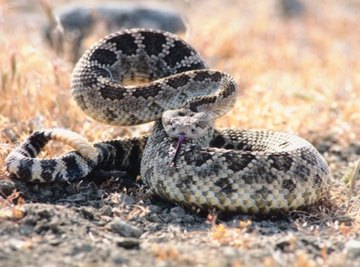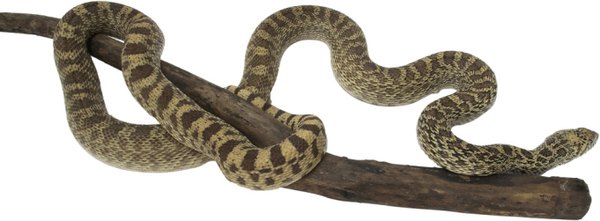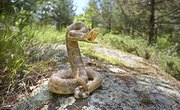
Gopher snakes and rattlesnakes resemble each other superficially. They have the same sort of markings and colors, and both snakes can be a bit short-tempered. The longest rattlesnake is about 9 feet long, and the fangs of a big rattlesnake can grow up to an inch long. But most rattlesnakes only grow to 5 feet long. The gopher snake grows from 6 to 9 feet long. Both snakes eat rabbits, squirrels, mice and other rodents. But there are differences.
Pits
Rattlesnakes are pit vipers, which means they're venomous and have facial pits between their eyes and their nostrils. These pits sense the temperature of what’s in front of them. The rattlesnake's pits can detect temperature differences of as little as one third of a degree Fahrenheit, which helps the snake when hunting at night. The gopher snake doesn’t have pit organs and is nonvenomous.
Rattles

The rattlesnake has a set of rattles that are unique to its group. The rattles are made by specialized scales at the end of the tail. A baby rattlesnake is born with a little button on the end of its tail that’s lost after the first molt but then replaced. After several molts the rattle begins to form. The number of rattles don’t correspond to the snake’s age because rattlesnakes molt several times a year. The gopher snake doesn’t have rattles but will strike if it’s cornered.
Reproduction
Rattlesnakes give birth to live young, and the length of pregnancy can differ dramatically. The southern prairie rattlesnake gives birth after a few months, but its northern counterpart takes a year longer to give birth. Rattlesnakes give birth to around six to 21 young. The gopher snake lays two to 24 eggs per clutch, and the young hatch after about 65 to 75 days.
Habitat
The gopher snake is the Pacific version of the bull snake and gets its name because it includes pocket gophers in its diet as well as other rodents. It lives in woodlands, deserts, farms, prairies, chaparral and shrublands, just about every habitat but the high mountains. It's a colubrid and has a scale on the tip of the snout that's turned upward toward the head to help it burrow. Because it does eat rodents, the gopher snake is popular with farmers. The rattlesnake is most prominent in the Southwest and in Mexico. A few species are found east of the Mississippi river, including the eastern diamondback rattlesnake and the timber rattlesnake.
Behavior
Gopher snakes are notable for their hissing. They have a membrane at the front of their windpipe which vibrates when they’re angry, which gives the hissing sound more power. Gopher snakes are constrictors, which means they suffocate their prey. Rattlesnakes use venom to overcome their prey and use their rattles to warn away enemies. Gopher snakes also can make excellent pets after they’re captured. Very few people would make a pet out of a rattlesnake.
References
- "Snakes of the World"; John Stidworthy; 1983
- "Reptiles and Amphibians"; Herbert S. Zim, Ph.D.; 1956
- Animal Diversity Web; Crotalus Adamanteus; Information; Erin Siebert; 2000
- Animal Diversity Web; Pituophis Catenifer; Information; Josh Albert; 2008
Photo Credits
Jupiterimages/Photos.com/Getty Images
